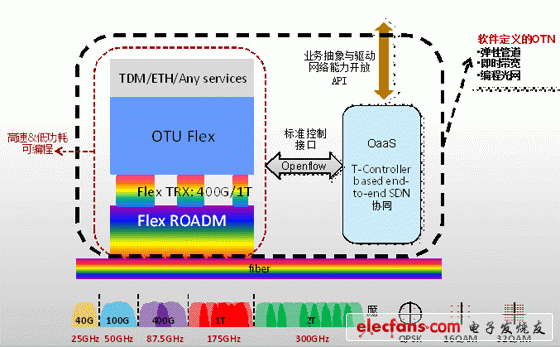Challenges faced by traditional optical transport networks 1. Rapid growth of traffic, single carrier capacity is approaching the limit With the development of the Internet in recent years, the number of Internet users, types of applications, and bandwidth requirements have all shown explosive growth. Taking China as an example, the annual growth rate of mainline traffic in the next 4 to 5 years will be as high as 60 to 70%. The total bandwidth of the backbone transmission network will increase from 64Tb / s to around 150Tb / s or even above 200Tb / s. Facing the huge digital torrent, the demand for ultra-high-speed optical interfaces has emerged in large numbers. The line transmission rate has gradually evolved from 40G / 100G and 400G / 1T +. After over 100G, multi-carrier technology is the trend. The flexible adjustment of resources to improve the overall spectrum utilization efficiency of the network has become the primary issue for the next step of development. 2. New applications are emerging one after another, how to release floods for dynamic services With the widespread application of cloud computing and data centers, various new types of new services and applications have emerged. In addition to the huge digital torrent, the transmission network will also face the dynamics and unpredictability of the torrent. The traditional optical transmission network is based on a fixed-rate OTN interface, a fixed spectrum interval at the optical layer, and layer-by-layer separation management. Its "over provisioning" and "static connection" (staTIc connecTIvity) characteristics are under this situation. Seemingly inefficient, it is necessary to establish a flexible and open new architecture to achieve "automatic deployment" and "instantaneous bandwidth adjustment". Software-defined OTN architecture The software-defined optical transmission network is an optical transmission architecture that can be dynamically adjusted by software through flexible and programmable configuration of hardware. Its core technologies include: flexible and variable optical and electrical functional modules, building high-speed, low-power programmable optical systems, supporting Openflow standard control interfaces and open application interfaces (APIs), and using programmable transmission controllers (Programmable Transport Controller) to realize optical network programmability and resource cloudization, so as to provide efficient, flexible and open pipeline network services for different applications. The system architecture is shown in Figure 1. Figure 1 Software-defined OTN system architecture Software-defined OTN has three major characteristics of "elastic pipeline", "instant bandwidth" and "programmed optical network", which can meet the requirements of rapid deployment of different services in the future, bandwidth allocation on demand, and easy maintenance and management of the network, which can effectively reduce operators. TCO, improve profitability.
Make your business brand or logo stand out in ways
common signage simply can`t match!
A great way to make your company name, logo
or promotional message stand out, custom Neon Sign Logo is a specialty.
Neon Sign Logo Neon Sign Logo,Custom Led Logo,Light Up Logo Signs,Led Logo Shenzhen Oleda Technology Co.,Ltd , https://www.baiyangsign.com